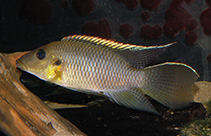| Family: |
Cichlidae (Cichlids), subfamily: Pseudocrenilabrinae |
| Max. size: |
13 cm SL (male/unsexed) |
| Environment: |
benthopelagic; freshwater, |
| Distribution: |
Africa: Ogooue system, Gabon; specimens identified as C. kingsleyae from localities outside the Ogooue basin are presumed to be misidentifications, most often of C. mamonekenei and C. melaniae (Ref. 81260). |
| Diagnosis: |
Dorsal spines (total): 14-15; Dorsal soft rays (total): 10-12; Anal spines: 3-3; Anal soft rays: 6-8. Diagnosis: 15-19 gill rakers on first gill arch; no large spots on flanks; 4-6 bands or 2 rows of dark blotches and short horizontal lines usually visible when stressed; body depth 25.9-39.6%, mean 35.1% standard length; lachrymal depth 24.6-26.8% head length, mean 25.6% HL); base body coloration light brown to ochre; caudal fin rounded to slightly truncate in females, truncate or with some elongate rays in upper lobe (occasionally also in lower lobe) in males; males one third larger than females (Ref. 81260).
Description: relatively robust (body depth 25.9-39.6%, mean 35.1% SL); snout prominent, long and acute (snout length 27.2-46.5%, mean 37.9% HL); caudal peduncle normally deeper than long, occasionally longer than deep; 9-12 (median 10) tuberculate hypobranchial and ceratobranchial rakers, 4-8 (median 7) lanceolate epibranchial rakers; 2-2.5 rows of scales between 8th pored scale of upper lateral line and dorsal fin base; in adults of both sexes, first pelvic ray longest, particularly so in males; some dorsal and anal fin rays produced (Ref. 81260). Caudal normally slightly rounded to subtruncate in both sexes, however, in some populations upper rays of caudal fin in males are produced and in one population (“Atogafina” in the region of Monte Cristal) both upper and lower rays of the caudal fin are markedly produced (Ref. 52307, 81260). Actual body shape can vary: specimens from rapidly flowing waters are remarkably more slender than the deep-bodied individuals found in slower flowing areas (Ref. 52307).
Coloration: body brown, paler ventrally (Ref. 52307, 81260). Body scales in males with dark margination; cheek and opercle with a yellowish green iridescent flush; soft dorsal, anal and caudal fins in males with small red and pale blue maculae, which are usually poorly developed or absent in females (Ref. 52307, 81260). Spinous dorsal, upper half of soft dorsal and often upper lobe of caudal fin in both sexes with a silvery white to rosy coloration; fin coloration always more prominent in females than males; dorsal fin and upper part of caudal with red margin in both sexes, but more pronounced in males (Ref. 81260). Sometimes 2 rows of interrupted horizontal black stripes on body, but occasionally they are uninterrupted (Ref. 52307, 81260). Females exhibit a broader and bolder iridescent zone on their dorsal fin, as well as (in many specimens) the upper parts of the caudal fin; rarely some dusky and irregular vertical bats are seen on the body, mostly in brooding females (Ref. 52307). |
| Biology: |
Omnivorous, preferring smaller particles including small fish, albeit rarely (Ref. 52307). Polygamous, ovophilic, female mouthbrooding species (Ref. 52307, 81260) that does not form pair bonds (Ref. 52307). Maximum TL was recorded at 16.5 cm (Ref. 5616). |
| IUCN Red List Status: |
Least Concern (LC); Date assessed: 16 February 2009 Ref. (130435)
|
| Threat to humans: |
harmless |
| Country info: |
|
Source and more info: www.fishbase.org. For personal, classroom, and other internal use only. Not for publication.

